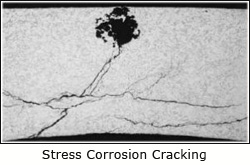 Corrosion with rusting of reinforcement in concrete comprises two stages. In a first stage (or step), the aggressive elements, such as chloride or carbon dioxide (CO2) (Cl-), present in the surrounding medium, penetrate in concrete. This is the initiation stage. The second stage is propagation which starts, when these aggressive bodies are in rather high concentrations at the reinforcement level. This corresponds to the rust growth, which can break concrete cover. Corrosion with rusting of reinforcement in concrete comprises two stages. In a first stage (or step), the aggressive elements, such as chloride or carbon dioxide (CO2) (Cl-), present in the surrounding medium, penetrate in concrete. This is the initiation stage. The second stage is propagation which starts, when these aggressive bodies are in rather high concentrations at the reinforcement level. This corresponds to the rust growth, which can break concrete cover.
These stages are described as follows.
- a first stage involves the transfers of aggressive agents (mainly carbon dioxide and chloride) of water and of oxygen, inducing the Corrosion initiation (depassivation of reinforcement),
- a stage of Corrosion growth, leading to concrete damage, to spalling, cracks, etc. This stage starts when the contents of aggressive agents are high enough closed to reinforcing steel.
So, to describe steel Corrosion in concrete, it is advisable to define, on the one hand, the penetration of the aggressive agents through concrete and, on the other hand, the conditions of depassivation of reinforcement, then the dissolution rate of metal and the rust growth. |